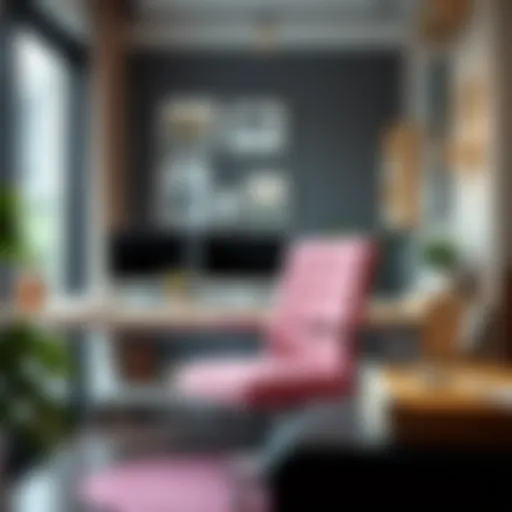Mastering the Unfinished 60 Inch Vanity
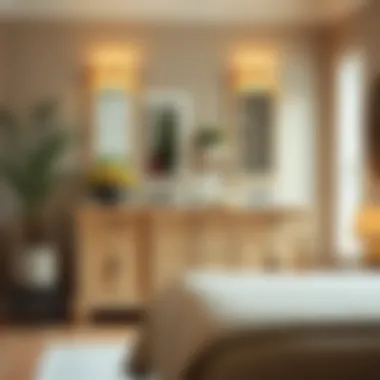

Intro
An unfinished 60-inch vanity stands out as a practical yet versatile choice for those looking to customize their bathroom space. It provides not just functionality, but also serves as a blank canvas, allowing homeowners to express their personal style. The allure of unfinished furniture often lies in its potential for customization, inviting creative minds to forge something truly unique. As we journey through this guide, we will explore the many facets of selecting, designing, and maintaining an unfinished 60-inch vanity.
While the mere mention of a vanity may conjure images of a sterile, standard bathroom fixture, an unfinished vanity invites far more creativity and consideration. From various designs and materials to practical maintenance tips, this guide intends to inform both seasoned designers and homeowners dipping their toes into DIY projects.
This article lays out key insights into how to choose the right vanity, incorporate the latest design trends, and appreciate the craftsmanship behind a quality piece. It promises to eject the mundane and empower readers to make choices that resonate with their aesthetic preferences and functional needs. Let's get started on this informative trip through the world of unfinished vanities.
Prologue to Unfinished Inch Vanities
Selecting the right vanity can transform a bathroom from a mere functional space to a stylish sanctuary. Among the various choices available, unfinished 60-inch vanities are gaining traction for their versatility and customization potential. This section unpacks the significance of unfinished vanities, addressing their unique benefits and the considerations for homeowners looking to make a thoughtful choice.
Understanding Unfinished Furniture
Unfinished furniture brings with it a certain charm, almost like a blank canvas. When homeowners opt for this type of furniture, they are essentially inviting possibilities into their home. One of the primary appeals of unfinished furniture is the ability to customize—painting or staining to suit personal preferences, which can often lead to a more cohesive look in a bathroom.
Unlike fully finished furniture, which can sometimes limit creativity, unfinished vanities allow for various finishes. This opens up a world of color, texture, and style. Homeowners and designers alike can match their choice of vanity with existing decor or even create something entirely unique. It’s an opportunity to express oneself amid the snug confines of bathroom space, where choices can otherwise be limited.
Besides customization, it’s crucial to recognize that unfinished furniture tends to be more affordable than their finished counterparts. This cost-effectiveness makes it particularly appealing, especially to DIY enthusiasts who relish the challenge of putting their own stamp on a piece.
The Appeal of a Inch Vanity
The 60-inch vanity is often seen as the goldilocks choice—not too large, and not too small. It strikes the right balance for homeowners who desire ample storage and surface area without overwhelming the bathroom. This size can be particularly advantageous in larger main bathrooms or shared spaces, allowing for two sinks and additional storage capacity underneath.
Another compelling aspect of a 60-inch vanity is its adaptability. These vanities fit well into a variety of design styles, whether you lean toward modern minimalism or rustic charm. They can harmoniously blend with subway tiles, elegant fixtures, or even reclaimed wood accents, making them a worthy candidate for diverse decorating schemes.
Furthermore, the appeal of a 60-inch vanity extends to its practical use. With more counter space, one can accommodate toiletries and decorative items alike. Think of the convenience; everything you need close at hand, and still enough room for a swiftly moving morning routine.
In summary, an unfinished 60-inch vanity is more than just a practical addition to your bathroom—it’s an embodiment of individuality, blending functionality with personal design choices. As this guide progresses, we will dive deeper into the myriad of choices available, helping you navigate through options that align with your vision and needs.
Benefits of Choosing an Unfinished Vanity
When it comes to selecting a vanity for your bathroom, an unfinished version offers distinct advantages. This option not only opens the door to personal expression but also serves practical needs that matter to homeowners and designers alike. In this section, we dive into the key benefits of choosing an unfinished vanity, showcasing why this style can be a hidden gem in your bathroom renovation endeavors.
Customization Options
One of the most enticing features of choosing an unfinished vanity is the plethora of customization options at your fingertips. Unlike pre-finished pieces, an unfinished vanity invites you to let your creativity run wild. Whether you gravitate towards a rustic finish that speaks of farmhouse charm or a modern stain that complements sleek lines, the choice is yours.
- Personalized Staining and Painting: You can pick the exact color or stain that fits your vision for the space. Imagine a deep walnut that brings warmth, or a chic white that reflects light beautifully, making your bathroom feel larger.
- Hardware Selection: Selecting your own fixtures allows for even more personalization. Choose hardware that brings out the character of the wood or contrasts it in interesting ways.
- Size Adjustments: With unfinished vanities, you can often modify dimensions if needed. That one inch can make all the difference in how your vanity fits into your space, especially when balancing function with aesthetic.
Customization doesn’t just make the vanity fit your style; it turns the process of selection into a rewarding project. Engaging in this degree of personalization means your vanity won’t just be furniture—it becomes a reflection of your taste.
Cost-effectiveness
Another compelling reason to consider an unfinished vanity lies in its cost-effectiveness. Often, these vanities are priced lower than their fully finished counterparts. But the cost savings aren’t just limited to the initial purchase price; they extend beyond that in several ways.
- Reduced Labor Costs: If you choose to finish it yourself, you sidestep labor expenses associated with professional finishing. This DIY approach not only saves money, but also empowers you to create exactly what you envision.
- Quality Over Aesthetics: Many unfinished vanities are made with solid wood and robust construction techniques. These products often outperform their finished counterparts, which may prioritize appearance over build quality. Investing in an unfinished piece means you get reliability without breaking the bank.
- Long-term Value: Once finished to your liking, an unfinished vanity can maintain its charm and integrity for years. Homebuyers often appreciate unique features, meaning your vanity could very well enhance your home’s resale value.
To sum it up, an unfinished vanity stands out not just for the swap-meet of beauty and utility, but also for its value. It’s an investment that pays off, both in style and in wallet.
"The true beauty of furniture lies in its ability to be transformed, reflecting both personal style and practical needs."
Material Choices for Unfinished Vanities
Choosing the right material for your unfinished vanity is crucial as it not only determines its longevity but also affects its appearance and functionality. The materials used can make or break the overall look of your bathroom. When selecting a vanity, you should consider durability, ease of maintenance, and how well it aligns with your personal style and the existing decor.
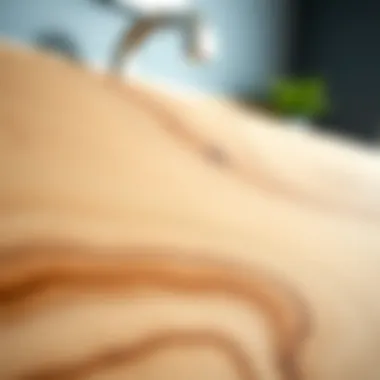
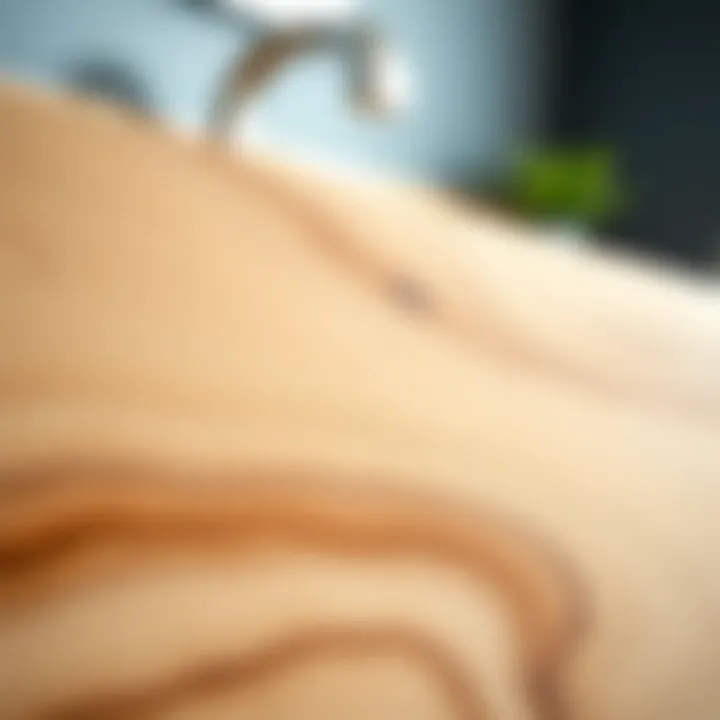
Types of Wood Used
Hardwood Options
Hardwood options are a solid bet when it comes to unfinished vanities. Species like oak, maple, and cherry bring a level of durability that can withstand the test of time. These woods are usually denser and less prone to wear and tear, making them ideal for a busy bathroom setting. A key characteristic of hardwood is its rich grain patterns, which can add an aesthetic appeal that softwoods can seldom match.
One unique feature of hardwood is its ability to hold finishes beautifully, allowing you to customize your vanity with stains or paints that really pop. However, hardwoods can be pricier than their softwood counterparts, and this might not always fit into everyone's budget. Ultimately, if you're looking for a long-term investment that enhances both style and function, hardwood is a fantastic choice.
Softwood Considerations
On the other hand, softwoods bring their unique merits to the table. Materials like pine and fir are often lighter and more cost-effective than hardwoods, making them accessible for various budgets. The key characteristic of softwood is its ease of workability, which is especially beneficial if you're planning to do some DIY modifications.
A unique feature of softwood is its warm tones and natural knots, offering a rustic charm that many find attractive. However, it’s important to note that softwoods can dent and scratch more easily, so they typically require a bit more care. For those looking for a balance between beauty and functionality on a budget, softwoods can certainly be a favorable option.
Alternative Materials
Engineered Wood
Engineered wood has gained traction in the market for unfinished vanities due to its blend of affordability and durability. Composed of multiple layers of wood fibers and adhesives, this material offers superior resistance to warping compared to solid wood. A notable point is its environmental appeal; engineered wood uses fewer raw materials and can often be sourced from sustainable practices.
One advantage of engineered wood is that it can mimic the appearance of hardwood while often being lighter on the wallet. However, it's essential to select high-quality engineered veneers, as lower grades may not have the same longevity or visual appeal.
Reclaimed Wood
Reclaimed wood tells a story all its own, representing a sustainable building material that piques interest among eco-conscious consumers. Sourced from old buildings, barns, and furniture, this wood often showcases unique colors and textures that you simply cannot replicate. The charm of reclaimed wood lies in its character, often displaying imperfections that add to its allure.
One significant advantage of reclaimed wood is its eco-friendliness, as it reduces the demand for new lumber. But keep in mind that it might require a bit more care in terms of stability since the aging process can affect its durability. For those wanting a one-of-a-kind look that also benefits the planet, reclaimed wood is definitely worth considering.
"Selecting the right material is not just about aesthetics; it's about making a lasting choice that meets your needs for years to come."
Engaging with these material options opens up a world of possibilities for your unfinished 60-inch vanity. Each material has its own unique offerings, and understanding their merits and drawbacks will help you make an informed decision tailored to both your functional needs and design preferences.
Design Considerations for Unfinished Inch Vanities
When selecting an unfinished 60-inch vanity, the design aspect cannot be overlooked. It plays a critical role in how well the piece melds with the overall aesthetic of your bathroom. The right design consideration can elevate functionality and beauty, ensuring your vanity isn't just a piece of furniture, but a focal point in your space.
It's essential to think about the style that resonates with you, whether it be contemporary, classic, or an eclectic mix. Furthermore, an unfinished vanity offers a unique opportunity for personal expression through customized finishes. Understanding the various styles and how they integrate into existing decor enhances the appeal of unfinished options. Ultimately, aligning your vanity with your bathroom's design theme can create a cohesive ambiance.
Choosing the Right Style
Modern Aesthetics
Modern aesthetics often reflect minimalism, clean lines, and a focus on functionality. Here, simplicity serves as a canvas for self-expression, appealing to those who appreciate a streamlined environment. The key characteristic of modern design is its emphasis on uncluttered surfaces, which can lend a fresh, spacious feel to your bathroom.
One unique feature of modern aesthetics is the use of bold colors along with neutral tones, allowing homeowners to experiment with vibrant hues without overwhelming the space. This choice fosters a striking contrast against natural wood's organic appeal.
The advantage of choosing a modern style for your unfinished vanity is its adaptability. Modern designs can seamlessly fit into a variety of spaces, from sleek urban apartments to suburban homes. However, an overly stark modern design may lack the warmth some homeowners desire, so balancing it with other elements is crucial.
Rustic Charm
Rustic charm embodies the essence of coziness and warmth, often characterized by reclaimed wood and weathered finishes. The embrace of imperfections is pivotal; this style speaks to those who appreciate the narratives behind each piece of wood. Its key characteristic is a connection to nature, inviting elements like raw textures and earth-toned palettes into the home.
A unique feature of rustic charm is how it can make a space feel lived-in and welcoming. The use of aged finishes not only adds depth but also celebrates the craftsmanship inherent in unfinished materials.
The advantage of opting for a rustic-styled vanity lies in its timeless appeal. It can create a certain nostalgia and can integrate beautifully with vintage accessories. However, some may find the style too predictably cozy or too rustic for modern tastes, so it might require clever accessorizing to balance out the look.
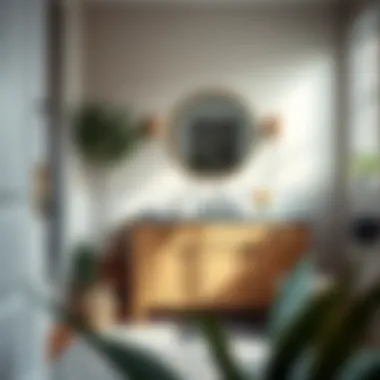
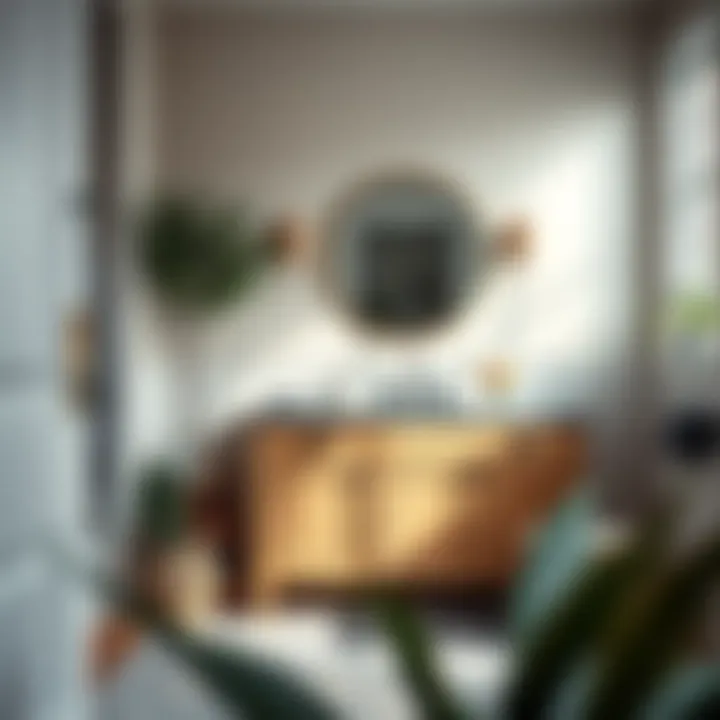
Integrating with Existing Decor
Integrating an unfinished vanity into your existing decor is a balancing act that requires thoughtful consideration. The color scheme, texture, and overall theme of the bathroom should align with the chosen vanity style. For instance, modern vanities harmonize well with industrial fixtures and sleek tiles, while rustic options can complement vintage accents and matte finishes.
To achieve a harmonious design, start by assessing your current color palette and textures. One helpful way to visualize this is to create a mood board that includes samples of your tiles, paint colors, and other furnishings to see how they interact with potential vanity styles visually. In short, a well-integrated vanity design can elevate the overall aesthetic of your bathroom.
Installation of Unfinished Vanities
When it comes to incorporating an unfinished 60-inch vanity into your bathroom, the installation process cannot be overlooked. It's not just about nailing down a piece of furniture; it’s about creating a functional and aesthetically pleasing space. A proper installation ensures that the vanity stands the test of time, both in durability and style. Not only does a well-installed vanity elevate the overall look of your bathroom, but it also enhances usability. A few key elements to keep in mind include ensuring plumbing compatibility, leveling, and securing the vanity to the wall to prevent tipping. Let’s delve deeper into how to effectively prepare for and execute your installation.
Preparation for Installation
Preparation is a critical step in the installation journey of any unfinished vanity. Without proper groundwork, even the most beautiful piece can become a headache. Here’s what to consider:
- Assess Space and Layout: Before anything else, take a good look at your bathroom space. Measure the area where the vanity will go, ensuring it fits comfortably without overcrowding the room.
- Gather Tools and Materials: You’ll need some essential tools for this job. Stock up on a measuring tape, level, screws, a power drill, and possibly a saw if adjustments are necessary. Don’t forget protective gear, like goggles and gloves.
- Plan for Plumbing: Check your existing plumbing setup. If your new vanity has different plumbing requirements, you may need to adjust pipes or fittings. Making these changes during installation will save you time and effort later.
- Read the Instructions: Each vanity might come with specific instructions. Give those a thorough read. They often contain valuable tips or hints for a smoother assembly.
Step-by-Step Installation Guide
Installing your unfinished vanity can feel daunting, but breaking it down into steps simplifies the process. Here’s a straightforward guide to help you through:
- Mark the Wall: Use a level to draw a line where the top of the vanity will sit. This will serve as a guideline to ensure that the vanity is installed at the right height.
- Connect the Plumbing: Before positioning your vanity, connect the drain and supply lines to the sink. It can be easier to do this before the vanity is secured.
- Position the Vanity: Place the vanity in position, aligning it with your markings. Check again with the level to make sure it’s straight.
- Secure to the Wall: Once you’re satisfied with the placement, it’s key to secure the vanity to the wall. This step prevents it from tipping over and ensures stability. Use wall anchors if the vanity is not against a stud.
- Install the Sink: If your vanity is separate from the sink, install the sink according to the manufacturer’s instructions. Make sure the seals are tight to avoid leaks.
- Final Touches: After the sink is in place, connect the faucet, ensuring all plumbing connections are tight. Lastly, check for any gaps or uneven areas and fill them as needed for a polished finish.
Remember that patience is a virtue here. Rushing could lead to mistakes that might cost you more hassle down the line.
Getting this installation right not only protects your investment but enhances the comfort and usability of your bathroom. With careful preparation and straightforward installation steps, your unfinished vanity can quickly transform into a lasting centerpiece in your space. As on-going upkeep is crucial, don’t forget to factor in maintenance practices later on in the guide.
Finishing Techniques for Unfinished Vanities
Choosing the right finishing techniques for unfinished vanities is not just an aesthetic choice but a vital component of their longevity and usability. When you purchase an unfinished vanity, you are not just acquiring a piece of furniture; you are laying the groundwork for a work of art that reflects your personal style. Proper finishing enhances the wood’s natural beauty, protects it from the wear and tear of daily use, and ensures that the piece stands the test of time in the demanding environment of a bathroom.
Staining Options
Staining is often the first step in finishing an unfinished vanity. It’s an avenue to awaken the wood's inherent character and grain, often enhancing its visual impact in a bathroom setting. Different stains bring different moods to a space. For instance:
- Dark stains can create a sophisticated, elegant atmosphere, perfect for modern aesthetics.
- Light stains might be more suited for a relaxed or rustic vibe, bringing an airy feel to a smaller bathroom.
When selecting a stain, consider the overall color scheme of the bathroom. Would a walnut finish harmonize with your tiles and countertops? Or does a soft maple stain provide that pop of contrast you are looking for? Remember to test the stain on a small, inconspicuous area first. This step ensures that you are satisfied with the outcome before committing.
Sealing and Protection
After the vanity has been stained, sealing is an essential next step. A good sealant acts as a barrier, protecting the wood from moisture, debris, and everyday wear. Bathrooms are often steamy environments where wood can warp if not adequately protected.
- Polyurethane finishes are popular because they offer strong protection and durability,
- Water-based sealants are a top choice for their low odor and quick drying times.
Whichever sealant you choose, ensure it’s specifically designed for the type of wood you've dyed. Applying the sealant carefully is key; it helps in maintaining the richness of the stain while giving the vanity a polished look. A well-sealed vanity should not only look great but also be easy to clean, adding to a streamlined maintenance routine.
Painting vs. Staining
This choice often stirs a spirited debate among DIY enthusiasts. While staining permits the natural beauty of the wood to shine through, painting offers a different palette of possibilities.
- Painting an unfinished vanity can be a fabulous way to bolden your space. A bright, glossy finish can make a powerful statement, particularly in cramped quarters where every visual trick counts. Whereas
- Staining allows for the wood’s texture and grain to become the center of attention.
Your final choice depends not only on aesthetic preferences but also on the functionality of the bathroom. If your vanity faces a lot of moisture, a solid paint may provide a more robust barrier compared to a stain.
Maintenance of Unfinished Vanities


Maintaining an unfinished vanity is a critical aspect for homeowners looking to preserve the utility and beauty of their investment. Unlike finished vanities, which may require lesser upkeep, unfinished versions demand a more attentive approach right from the onset. This special care makes all the difference in their longevity and aesthetic appeal. When you commit to an unfinished 60-inch vanity, you’re not just buying furniture; you’re embracing a canvas for personal expression.
Routine Care
Routine care is all about establishing a consistent maintenance regimen that keeps your unfinished vanity looking fresh and functional. Commonly, dust and debris can accumulate on surfaces, especially in areas where water splashes are frequent. A simple approach includes the following steps:
- Wipe Down Regularly: Using a soft cloth dampened with water or a gentle cleaner helps to remove dust and prevent stains. Avoid harsh chemicals or abrasive cleaners to keep the surface intact.
- Check for Moisture Damage: Since unfinished wood is more susceptible to moisture, regularly inspecting for any signs of water damage is crucial. If you notice warping or discoloration, addressing it promptly can prevent further issues.
- Use Coasters and Mats: Protecting the surface from spills and heat by using coasters or mats can prolong its life. This precaution is more than just a good habit; it safeguards your investment against inevitable wear and tear
In addition, applying a mild oil or wax finish every few months is recommended to rejuvenate the wood and maintain its natural beauty.
Long-term Durability Considerations
Considering long-term durability is vital when working with unfinished wood. Although these pieces have inherent beauty, they also require an understanding of how to make them withstand the trials of time. Here are some factors to contemplate:
- Climate Control: The environment plays a significant role in the integrity of your vanity. Keeping indoor humidity levels steady can help prevent warping or cracking.
- Sealing: One of the most proactive measures you can take is sealing your vanity with an appropriate finish once you have reached a desired look. A sealant protects the wood against moisture, dirt, and stains, which is critical for bathrooms where humidity tends to fluctuate.
- Frequent Inspections: Regularly checking for signs of wear, like scratches or dents, and taking swift action to remedy such issues can add years to the life of your vanity. Refurbishing damaged areas immediately is vital to maintain structural integrity.
"An ounce of prevention is worth a pound of cure." This especially rings true when discussing maintenance of unfinished vanities. It’s much simpler to prevent problems than to fix them down the line.
Additional Information
For those who want to dive even deeper into woodworking maintenance, resources from the following links can be immensely beneficial: Wikipedia on Wood Finishing, American Woodworker, and Fine Woodworking. These platforms offer a wealth of knowledge for those who take pride and joy in maintaining their furnitures.
Comparative Analysis of Brands and Models
In the world of unfinished vanities, making sense of the myriad choices can feel like trying to find a needle in a haystack. As homeowners or designers, knowing how to sift through the options is crucial. Each brand has its own ethos, design philosophy, and range of features which can impact not only the look of your space but also its functionality. This section aims to break down the importance of a thorough comparative analysis while focusing on specific elements that could sway your final decision.
When setting out to explore brands and models of unfinished 60-inch vanities, consider doing a side-by-side comparison. This comparison can reveal not only aesthetic differences but also distinctions in materials, craftsmanship, prices, and warranty offerings. Evaluating these elements helps you ensure that the investment you make aligns with your expectations and needs.
Evaluating Market Options
Starting with evaluation means casting a wide net. Begin by researching various brands available in the market. Look beyond mere sketches or renderings; seek out the libraries of online reviews, customer testimonials, and product detail pages to weave a comprehensive picture.
- Materials and Construction: Dive into the specs of the vanities. Are they built from solid hardwood, like oak or maple, or are engineered woods used? Solid woods tend to be more durable but come at a higher price.
- Design Features: Some models may offer integrated sinks or soft-close doors, while others prioritize aesthetic appeal with intricate carvings.
- Price Points: While price is often a telltale factor, don’t let it be the sole determinant. A lower-priced vanity could seem attractive, but it might compromise on quality, potentially leading to more costs down the line.
- Customization Options: Some brands allow for extensive customization, which can be a huge plus. You might find it beneficial to select specific stains or finishes that reflect your taste better.
Collecting all this data in an organized manner will help streamline your decision-making process, ensuring you choose the right fit for your bathroom remodel or design journey.
Brand Reputation and Warranty
Brand reputation carries significant weight when selecting an unfinished 60-inch vanity. A well-regarded manufacturer often signifies trustworthiness in terms of quality and customer service. Check for accreditation and read reviews on platforms such as Reddit, where real users share their experiences. Additionally, take a moment to explore the company’s presence on social media—positive interactions can often reflect a brand’s commitment to customer satisfaction.
- Warranty Information: It’s essential to scrutinize the warranties offered. Warranty length can vary widely, and a solid warranty often indicates confidence in their product. For instance, a five-year warranty suggests that the brand expects the vanity to withstand the pains of daily usage.
- Customer Support: Look for brands that provide considerable customer support. The availability of support not only during purchase but also after can make a significant difference. Being able to resolve a potential issue without hassle is invaluable.
"Selecting a brand with a strong reputation and good warranty can safeguard against future headaches, allowing you focus on the aesthetics of your space."
Taking the time to weigh these factors will equip you with a well-rounded view of what to expect from different models. Combining this knowledge with your unique design goals will bolster your chances of succeeding in the creation of a bathroom that reflects your style and meets your needs.
Epilogue and Final Thoughts
As we draw the curtain on this exploration, it's essential to acknowledge the role of unfinished 60-inch vanities in home design. They present not merely as mere fixtures but as canvases ripe for personalization. Each vanity holds potential, offering an exceptional opportunity for homeowners to express their unique style while ensuring functionality meets aesthetic appeal.
In various aspects we've discussed, from understanding the materials to installation and maintenance, an unfinished vanity stands as a testament to both versatility and quality. Let's recap the key points:
Recap of Key Points
- Customization Flexibility: The beauty of unfinished vanities lies in their adaptability. Whether one wishes to paint, stain, or leave the wood au naturel, choices abound.
- Cost-effective Option: Generally, unfinished vanities skirt around the higher price tags associated with fully finished units, allowing savvy buyers to achieve stunning looks without emptying their wallets.
- Durability and Longevity: Choosing the right materials can lead to a lasting fixture in your home, with proper upkeep extending the life of the vanity for years.
- Design Integration: These vanities can seamlessly fit into various styles, be it a modern bathroom or a rustic retreat, thanks to their customizable nature.
Simply put, the essence of investing in an unfinished 60-inch vanity lies in the blend of practical functionality and limitless creativity.
Future Trends in Vanity Design
Looking ahead, trends in vanity design seem to align with preferences for personalized and eco-friendly options. Homeowners are increasingly favoring sustainable materials—think reclaimed woods and low-VOC finishes. There’s also a movement towards innovative storage solutions that blend aesthetic appeal with practicality. In the near future, we might see more built-in features that cater to the multitasking nature of modern bathrooms.
As designers harness technology, smart features may also be integrated into vanities, offering solutions that align with the increasingly tech-savvy lifestyle of consumers.











